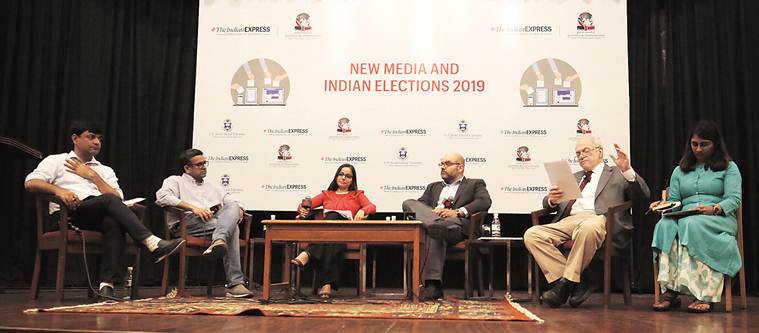
Social media is going to play a big part in the upcoming Lok Sabha elections, but it’s also a tool for disinformation and misinformation, said participants at the The Indian Express & Jindal School of Journalism and Communication’s (JSJC) panel discussion held at the India International Centre on Friday.
The panelists at the discussion on ‘New media and Indian elections 2019’ included Assistant Dean for Academics at the UC Berkeley Graduate School of Journalism Jeremy Rue, Project Lead at UC Berkeley’s Human Rights Center Pamposh Raina, The Indian Express National Chief of Bureau Ravish Tiwari and Editor, New Media, at indianexpress.com Nandagopal Rajan. The session was moderated by Tom Goldstein, Founding Dean, JSJC.
Speaking at the discussion, Raina said there was “a lot of misinformation about the attacker” after the Pulwama attack and even some of the mainstream media fell prey to it. She said “nobody could trace where it (source of misinformation) came from” and that journalists “accentuated the problem unknowingly”.
“The problem is that right now, no one has control over what is being shared on social media platforms and messaging groups. We don’t have a sense of why certain rumours get more attention than others,” said Raina.
Speaking about the use of social media in the presidential elections in the United States, Rue said, “Social media was not only used effectively. It was essentially weaponised by state actors to influence the outcome of the campaign”. He said that served as a “wake up call for Americans”.
“These terms of disinformation, misinformation and fake news are now part of our vocabulary… People are now (in the mid-term elections) more aware of the issue,” he said, adding that “internet was supposed to democratise free thought”, but that it was more a “double edged sword” currently.
Rajan said the 2019 elections would be different from the 2014 general elections. “In the case of 2014 elections and the run up to the 2014 elections, a lot of people got on to primarily Twitter, and also to Facebook because they wanted to follow what the political leaders were saying. The fact that Modi was there was a big driver for Twitter. It grew exponentially in the year running up to the elections. 2019 is very different. As far as Facebook and Twitter go, they’ve both hit saturation points in India. They haven’t grown for the past year or two years,” he said. However, he added that there were 300 million new mobile online users in India , who’ve added to WhatsApp, and “even WhatsApp doesn’t know what’s happening within WhatsApp (because of its encryption)”.
“For a lot of Indians who are coming to mobile or internet for the first time, WhatsApp is not a messaging platform. Maybe they are not even literate enough to have a conversation on WhatsApp. It’s a consumption platform for them, and they consume videos. Videos is where India’s big fake news problem lies. A video shot in Columbia is passed of as Indian because of the similarity in colour of people’s skin in both countries.Video can go without context, and 90 per cent of the time, it is without context,” said Rajan. Tiwari said the country was witnessing a new political culture, and that even political parties were “restructuring” themselves with IT cells at national and state levels and “full fledged team of multimedia creators who create videos, graphics etc”.
“A new kind of political organisation is coming into being. Earlier, a political worker would talk about his humble beginning, how he would ride on a bicycle for canvassing, going for street corner meetings. But that political worker has got a new element now because of social media. He doesn’t need to be on the field, he only needs to sit in New York and campaign for AAP as they did in 2013 and 2015, or sit in San Francisco and campaign for Narendra Modi in 2014,” said Tiwari.